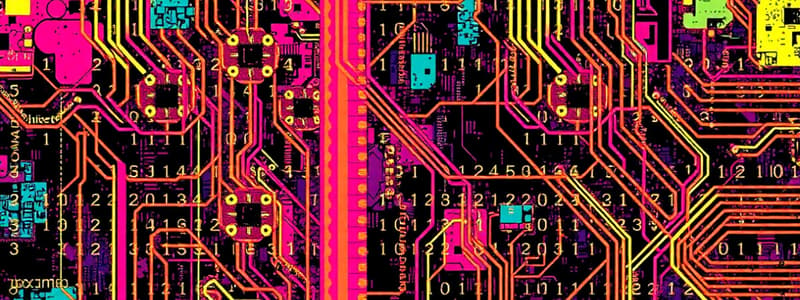Podcast
Questions and Answers
What is the name of the language that the computer understands?
What is the name of the language that the computer understands?
Machine Language
What is the name of the language that is close the machine language and uses a symbolic code?
What is the name of the language that is close the machine language and uses a symbolic code?
Assembly language
What is the name of the program that converts Assembly language to machine language?
What is the name of the program that converts Assembly language to machine language?
Assembler
Assembly Language is harder to learn than machine language
Assembly Language is harder to learn than machine language
What are the four fields of programming?
What are the four fields of programming?
The 'Comments' field in a program instruction helps the programmer to understand the code.
The 'Comments' field in a program instruction helps the programmer to understand the code.
What are the types of instructions used in Assembly language?
What are the types of instructions used in Assembly language?
What does MOV operation do?
What does MOV operation do?
What does the ADD operation do?
What does the ADD operation do?
The XLAT instruction is used to simplify lookup tables.
The XLAT instruction is used to simplify lookup tables.
The MUL and DIV operations do not affect the Carry Flag.
The MUL and DIV operations do not affect the Carry Flag.
What are the logical operations that are supported by the Assembly language?
What are the logical operations that are supported by the Assembly language?
The AND operation, in Assembly language, checks to see if both bits are 1.
The AND operation, in Assembly language, checks to see if both bits are 1.
The OR operation, in Assembly language, checks to see if at least one of the bits is 1.
The OR operation, in Assembly language, checks to see if at least one of the bits is 1.
The XOR operation, in Assembly language, checks to see if both bits are different.
The XOR operation, in Assembly language, checks to see if both bits are different.
The NOT operation, in Assembly language, inverts all the bits.
The NOT operation, in Assembly language, inverts all the bits.
The Carry Flag is only set by the DIV instruction.
The Carry Flag is only set by the DIV instruction.
The Overflow Flag is set when there is an overflow in a byte or word operation.
The Overflow Flag is set when there is an overflow in a byte or word operation.
Flashcards
Assembly language
Assembly language
A programming language that is close to machine language, using symbols and mnemonics to represent instructions.
Machine language
Machine language
The language that a computer directly understands and executes. It's based on binary code (0s and 1s).
Assembler
Assembler
A program that translates assembly language code into machine language. It's the assembler's job to make assembly code understandable by the computer.
Source program
Source program
Signup and view all the flashcards
Object program
Object program
Signup and view all the flashcards
MOV (Move) instruction
MOV (Move) instruction
Signup and view all the flashcards
Pseudo-instruction
Pseudo-instruction
Signup and view all the flashcards
Micro-instruction
Micro-instruction
Signup and view all the flashcards
Accumulator (AX)
Accumulator (AX)
Signup and view all the flashcards
Arithmetic instructions
Arithmetic instructions
Signup and view all the flashcards
ADD instruction
ADD instruction
Signup and view all the flashcards
SUB instruction
SUB instruction
Signup and view all the flashcards
INC (Increment) instruction
INC (Increment) instruction
Signup and view all the flashcards
DEC (Decrement) instruction
DEC (Decrement) instruction
Signup and view all the flashcards
NEG (Negate) instruction
NEG (Negate) instruction
Signup and view all the flashcards
Carry Flag (CF)
Carry Flag (CF)
Signup and view all the flashcards
Parity Flag (PF)
Parity Flag (PF)
Signup and view all the flashcards
ADC (Add with Carry) instruction
ADC (Add with Carry) instruction
Signup and view all the flashcards
SBB (Subtract with Borrow) instruction
SBB (Subtract with Borrow) instruction
Signup and view all the flashcards
XCHG (Exchange) instruction
XCHG (Exchange) instruction
Signup and view all the flashcards
XLAT (Translate) instruction
XLAT (Translate) instruction
Signup and view all the flashcards
Logical instructions
Logical instructions
Signup and view all the flashcards
AND operation
AND operation
Signup and view all the flashcards
OR operation
OR operation
Signup and view all the flashcards
XOR (Exclusive OR) operation
XOR (Exclusive OR) operation
Signup and view all the flashcards
NOT operation
NOT operation
Signup and view all the flashcards
Multiplication and division instructions
Multiplication and division instructions
Signup and view all the flashcards
MUL (Multiply) instruction
MUL (Multiply) instruction
Signup and view all the flashcards
DIV (Divide) instruction
DIV (Divide) instruction
Signup and view all the flashcards
Study Notes
Computer Architecture Course Notes
- Course Title: Computer Architecture 2
- Instructor: Dr. Rouda Mahebany
- Course Description: This course covers the fundamental concepts of computer architecture, focusing on assembly language instructions.
- This course is in the second year of information engineering.
Assembly Language Instructions
- Machine Language: The language directly understood and executed by the computer, using binary code (0s and 1s). It's complex and difficult for humans to write directly.
- Assembly Language: A symbolic representation of machine language using mnemonics (short codes). This makes the code easier to read, write, and understand for programmers.
- Assembler: A program that translates assembly language into machine language.
Mnemonics and Operations
- ADD: Adds two operands.
- SUB: Subtracts two operands.
- MOV: Copies data from a source to a destination.
- INC: Increments a value by one.
- DEC: Decrements a value by one.
- ADC: Adds two operands and carries (for multi-byte operations).
- SBB: Subtracts two operands considering borrowing.
Data Types and Registers
- Byte: Single-byte data.
- Word: Two-byte data (16-bit).
- Registers: Special memory locations to store data and intermediate results. Specific registers are often used for specific calculations.
Directives (Pseudo-Ops)
- Pseudo-operations: Instructions that tell the assembler to perform tasks like defining variables, allocating memory, or defining procedures. They are not translated into machine code.
XLAT Instruction
- XLAT: A lookup table instruction. It retrieves a value from a table in memory based on the content of the AL register.
Data Movement Operations
- The MOV instruction is used to move data from one location to another (registers, memory locations, or constants). The source location remains unchanged.
- Data movement operations involve transferring values between registers, memory locations, or between a register and a memory location.
Arithmetic Operations
- A variety of addition and subtraction operations are presented with the rules on use of the various operations.
- Data transfer and arithmetic operations are essential components of assembly language programming.
Logical Operations
- Logical instructions (AND, OR, XOR, NOT) perform logical operations on bits.
- Logical operations operate on the values of operands in bit-level operations, rather than calculations involving numerical values.
Studying That Suits You
Use AI to generate personalized quizzes and flashcards to suit your learning preferences.





